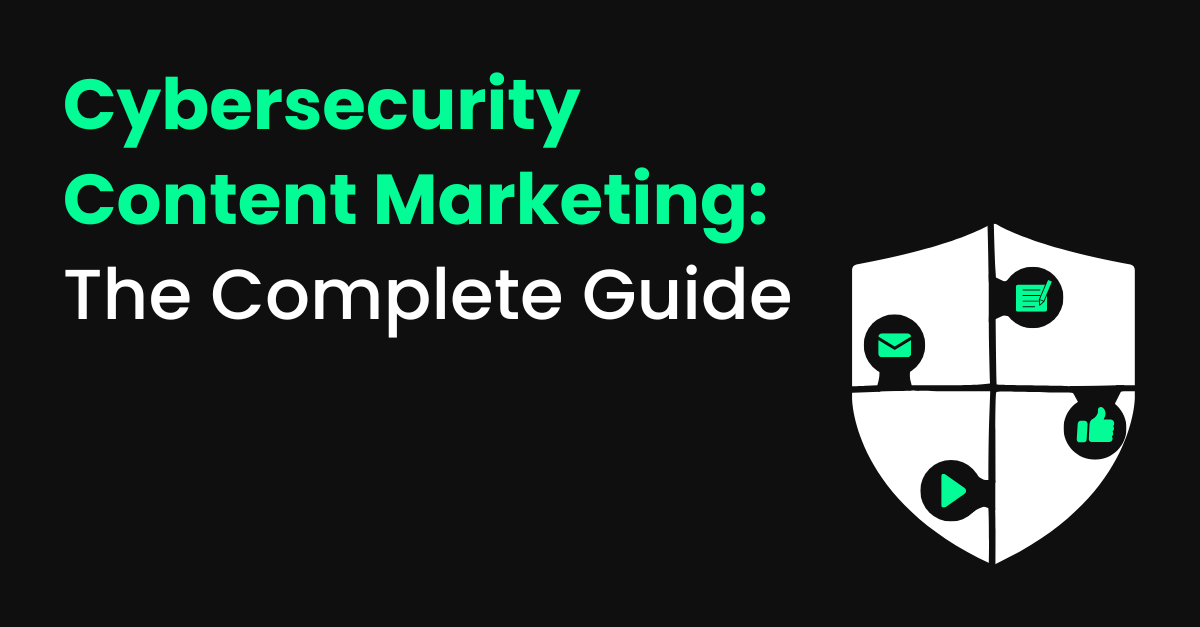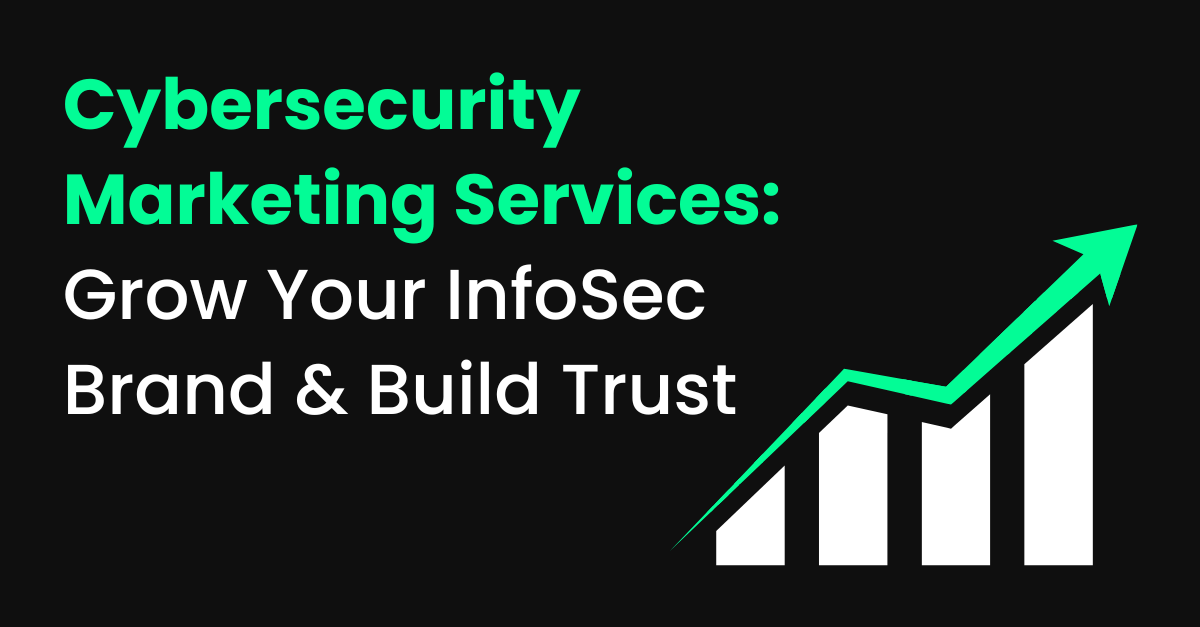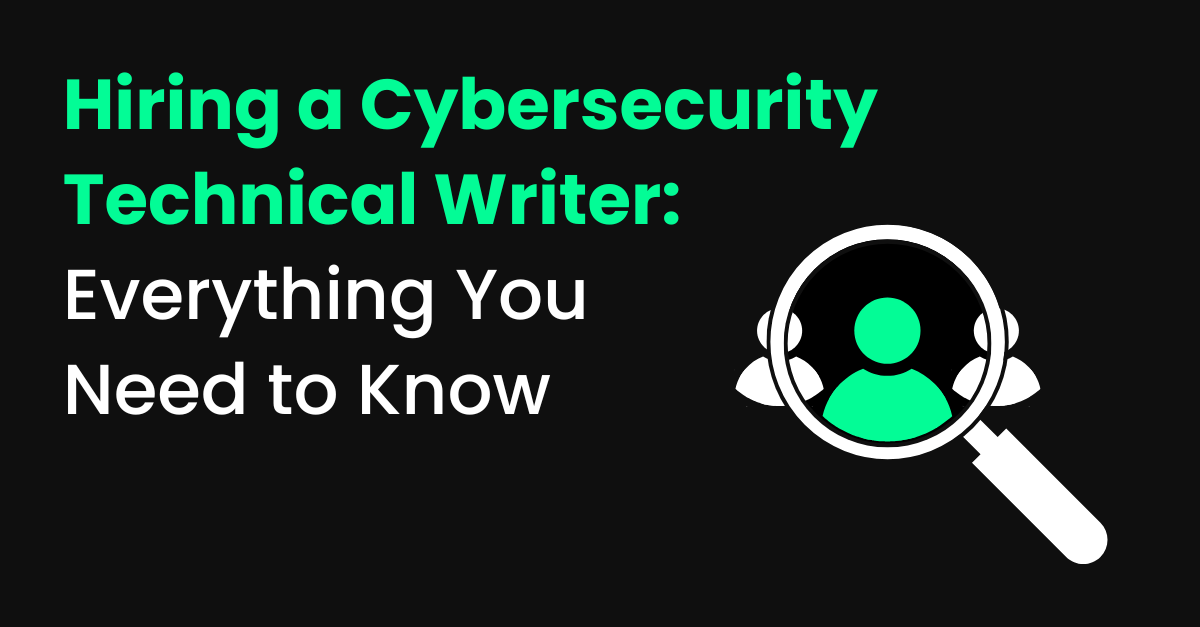Introduction
Cybersecurity marketing is tough; you’re selling invisible protection to skeptical buyers in a crowded, fear-driven market. That’s why clear, trustworthy content matters. It turns complexity into confidence, translating features into real business value and positioning your brand as the expert buyers rely on. In this article, you’ll learn how to build a cybersecurity content strategy that earns trust, drives pipeline, and stands out from the noise.
What Is Cybersecurity Content Marketing?
Cybersecurity content marketing enables cybersecurity companies to explain complex security topics in an approachable and useful manner. Instead of leading with buzzwords or product-heavy messaging, it focuses on building trust and clarity.
The goal is to create cybersecurity content that directly addresses real-world challenges — from preventing data breaches to managing ongoing cyber threats — and helps readers understand the practical impact of cybersecurity solutions. When done thoughtfully, it makes even technical details easy to follow and positions your brand as a reliable source of guidance in the cybersecurity industry.
A solid cybersecurity content marketing strategy is grounded in knowing your target audience. Security analysts, technical buyers, and executives all look for different types of information. Good content marketing meets each group where they are — through blog posts, white papers, or success stories that feel credible and relevant.
Adding search engine optimization helps the right people find this information through search engines and social media platforms. Over time, consistent and useful cybersecurity content strengthens brand recognition, supports your business goals, and helps potential customers feel confident about what you offer.
Why Cybersecurity Demands Its Own Approach
Cybersecurity marketing requires a tone that balances the technical and human aspects of trust. People shopping for cybersecurity solutions are cautious — and rightfully so. They’ve seen the impact of cyber threats and data breaches, so they want proof, not promises. Cybersecurity content marketing helps bridge that gap, translating complex security features into clear explanations that decision makers can understand and rely on.
For cybersecurity marketers, creating content means finding the right balance between detail and accessibility. Technical buyers want to see precision and credibility, while non-technical buyers want clarity and assurance. A cybersecurity content marketing strategy that delivers relevant content to both audiences helps cybersecurity companies stand out in a crowded cybersecurity market. It’s a way to build authority, encourage conversations, and help potential customers feel comfortable trusting your expertise.
Role in the Buyer Journey
Cybersecurity content plays a major role throughout the buyer journey. Initially, people are trying to understand cybersecurity threats and identify existing solutions. Educational content, such as blog posts, webinars, and explainer guides, helps with that. As they move deeper into research, they look for proof — things like white papers, success stories, or ROI data that demonstrate how a cybersecurity company solves real problems.
A thoughtful content marketing strategy connects these stages smoothly. When marketing efforts are aligned with buyer personas, each piece of cybersecurity content supports a specific decision-making moment.
Someone might find your company through search engines, read a helpful article, download a guide, and eventually talk to sales — all because the content made sense and felt trustworthy. That’s how effective cybersecurity content marketing helps turn interest into genuine relationships with prospective customers.
Why Cybersecurity Companies Need Content Marketing

Building Trust in a High-Risk Industry
Cybersecurity marketing, trust shapes every interaction. Buyers are aware of the risks associated with data breaches, cyber attacks, and system failures, which is why they scrutinize cybersecurity companies more closely. Cybersecurity content marketing helps close that trust gap by showing transparency, technical credibility, and a genuine understanding of customer pain points.
When cybersecurity firms share relevant content, such as success stories, white papers, and expert insights, they give potential customers confidence that their cybersecurity solutions can perform when it matters most. Consistent, well-researched cybersecurity content also strengthens long-term relationships, helping your brand stay credible and respected in a high-risk environment.
Translating Features Into Business Value
Cybersecurity content marketing is most effective when it translates technical features into tangible business outcomes. Instead of leading with terms like “machine learning detection” or “zero-trust architecture,” content should demonstrate how these capabilities mitigate cyber threats, enhance compliance readiness, or support overall business objectives.
Decision makers often lack a technical background, making clarity more important than complexity. Effective content marketing efforts highlight measurable value — fewer incidents, faster response times, or stronger data protection. A well-structured content strategy enables cybersecurity companies to link their technology to tangible results that resonate with both technical buyers and executives.
Establishing Authority
In a crowded cybersecurity market, authority separates trusted partners from ordinary vendors. Consistent, high-quality cybersecurity content positions your cybersecurity company as a thought leader — one that contributes to industry conversations rather than echoing them. Educational content, timely analysis of cybersecurity trends, and practical guidance for security analysts all show expertise in action.
Cybersecurity marketers who maintain a steady flow of engaging content across social media platforms, online forums, and industry publications build recognition and credibility over time. A well-executed cybersecurity content marketing strategy helps your audience see you as a trusted advisor they can rely on for accurate, actionable insight.
Key Challenges in Cybersecurity Content Marketing
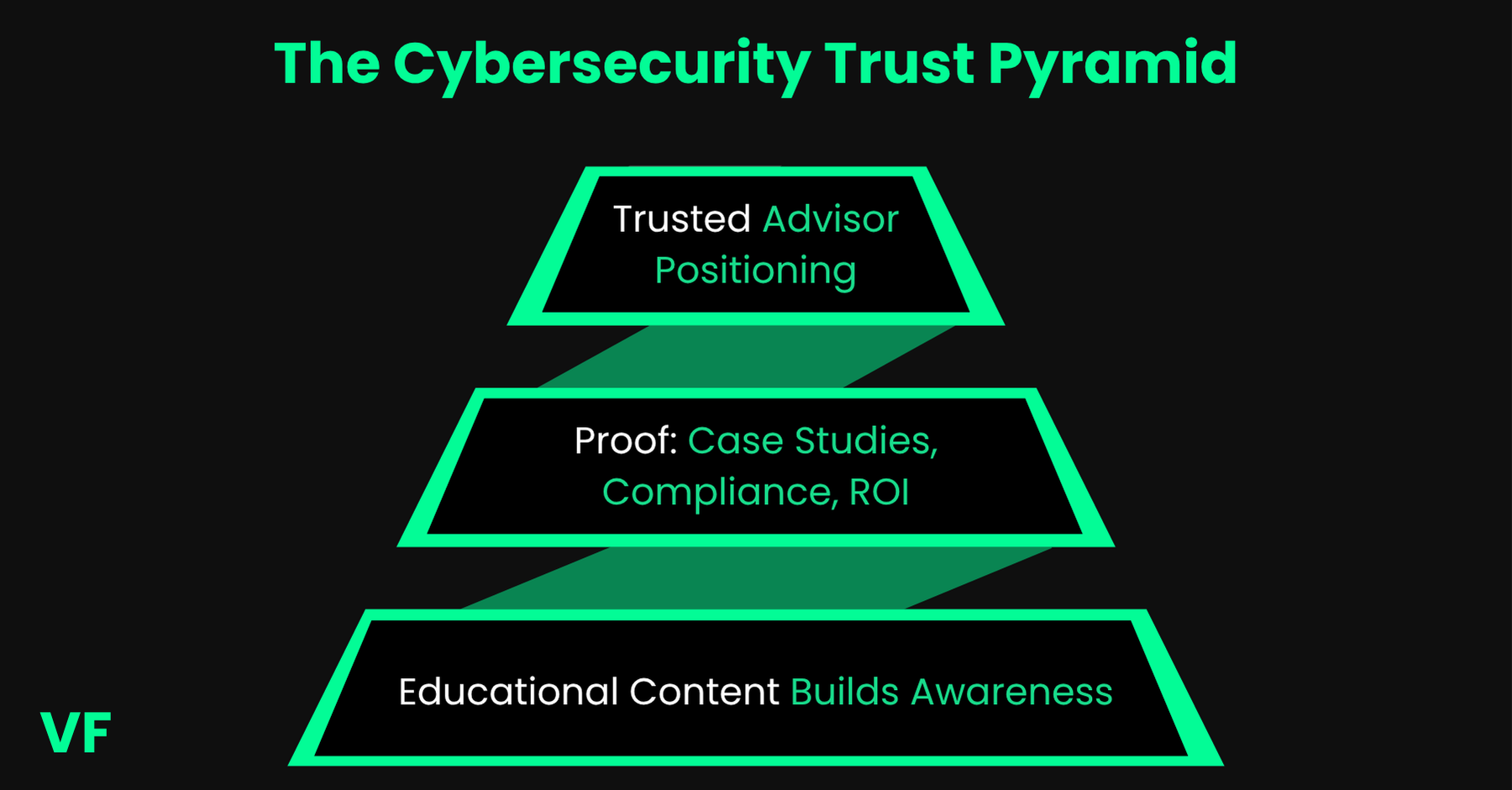
Market Saturation and Vendor Overlap
Currently, the cybersecurity space is saturated with vendors offering the same solutions — AI-driven detection, zero trust, and 24/7 protection. To stand out, your cybersecurity content marketing must prioritize substance over slogans. Focus on the “so what” behind your solution: measurable outcomes, customer proof, and the expertise that sets your team apart. Use first-hand insights from security analysts, detailed use cases, or success stories with real metrics. Content that showcases your unique perspective — rather than just product specs — quickly builds credibility. If every other vendor is making claims, be the one providing evidence.
Bridging Technical and Non-Technical Audiences
When creating cybersecurity content, remember that your readers won’t all share the same technical background. CISOs want strategic and financial clarity, while engineers care about technical depth and precision. To serve both, segment your content marketing efforts. Write executive summaries that translate ROI, compliance gains, or risk reduction, and link them to detailed technical resources like architecture diagrams or configuration guides. Map your content to buyer personas so everyone gets what they need. The best cybersecurity content marketing strategy doesn’t force a one-size-fits-all tone — it meets each audience where they are.
Balancing Fear vs. Confidence Messaging
It’s easy to lean too hard on fear in cybersecurity marketing, but that rarely builds trust. Instead, use your cybersecurity content to acknowledge real threats — such as ransomware, data breaches, and phishing — while showing practical paths to prevention. Highlight how your cybersecurity solutions enhance defenses, accelerate detection, or improve response times. Talk about resilience, not panic. Share lessons learned from incident response teams or customer success stories that show progress. Buyers respond better to confidence backed by proof than to exaggerated warnings, and that tone will make your cybersecurity company stand out as a steady, trusted partner.
Building a Cybersecurity Content Strategy
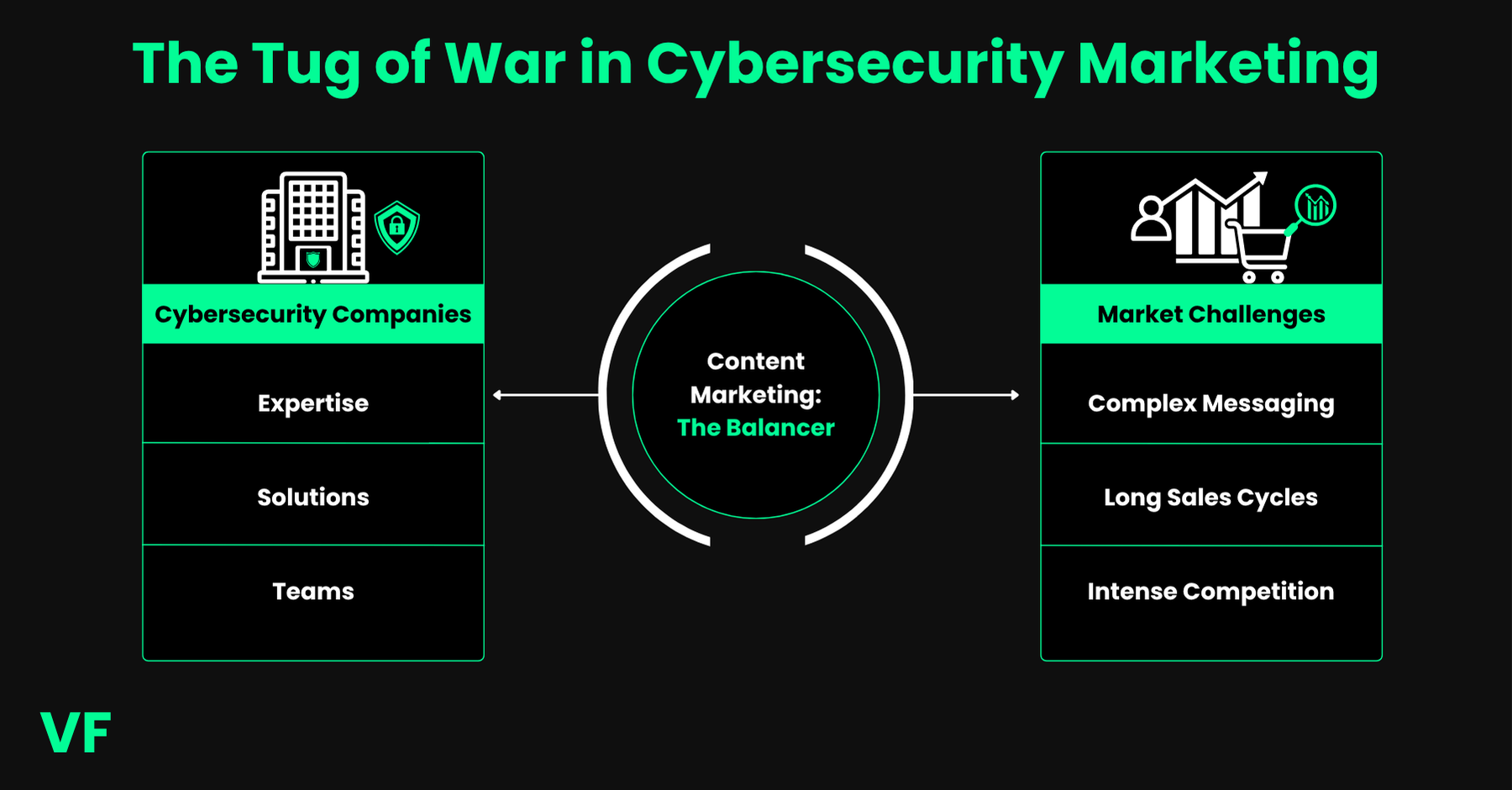
CISO – Strategic Risk Focus
When writing cybersecurity content for CISOs, speak directly to risk, compliance, and business impact. They care about how your cybersecurity solutions reduce exposure, protect reputation, and align with organizational goals. Use clear metrics like reduced breach probability, faster incident response, or improved audit readiness. Keep the messaging strategic — no deep technical jargon — and show how your cybersecurity company supports long-term resilience and executive decision-making.
IT Manager – Implementation Focus
IT managers want to know how cybersecurity solutions fit into existing systems and workflows. Focus your cybersecurity content marketing on deployment efficiency, integration with current tools, and post-launch management. Provide technical clarity on configurations, automation, and support requirements. When your content answers “how does this actually work in my environment?”, it builds immediate trust with this audience segment.
Developer – Integration Focus
Developers are hands-on and look for precise, technical details that show how your product interacts with APIs, codebases, or cloud environments. In your content strategy, include technical documentation, SDK examples, and blog posts that highlight integration best practices.
Avoid fluff — give them code snippets, performance benchmarks, and troubleshooting tips. The more practical your cybersecurity content, the faster you’ll earn credibility with this group.
End User – Usability Focus
End users focus on experience and security in their daily work. They want to understand how your cybersecurity solution keeps them safe without disrupting productivity. Create cybersecurity content that simplifies guidance, offers easy-to-follow tutorials, and highlights intuitive features.
Use clear language and real scenarios that help them feel empowered, not intimidated, by security tools. When users see that your solution supports both protection and convenience, adoption grows naturally.
Map Content to the Buyer Journey
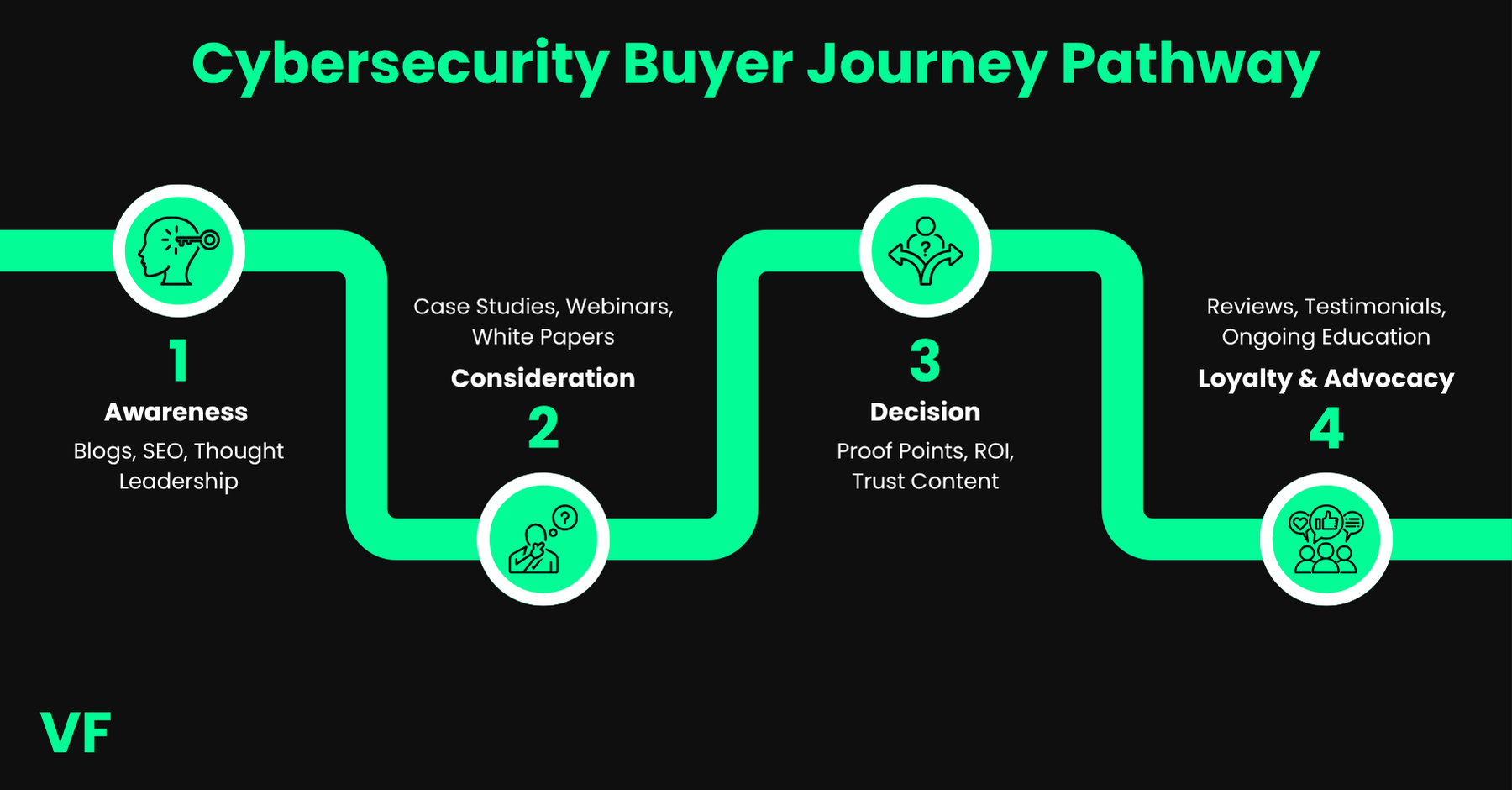
Each stage of the cybersecurity buyer journey requires content that addresses distinct questions. In the awareness stage, focus on thought leadership, blogs, and webinars that educate potential customers about cybersecurity threats and trends without selling. During consideration, develop in-depth resources such as case studies, white papers, and comparison guides that demonstrate how your cybersecurity solutions compare to others and address specific pain points.
When buyers reach the decision stage, provide them with tools to validate ROI — such as calculators, compliance checklists, and customer success stories that demonstrate real-world results. A clear, stage-specific content strategy helps cybersecurity companies guide buyers from first interest to confident purchase.
Integrate Sales and Marketing Alignment
Sales and marketing teams must be aligned for cybersecurity content marketing to be effective. SDRs and AEs should leverage existing content — such as targeted white papers, product one-pagers, and customer stories — in their nurturing sequences, rather than creating one-off assets. Marketing can support them with campaign-specific content mapped to funnel stages, while sales provides feedback on what resonates with real prospects. This collaboration transforms your content marketing efforts into a revenue-driving system, ensuring consistent messaging and more efficient lead progression through the pipeline.
Effective Types of Cybersecurity Content
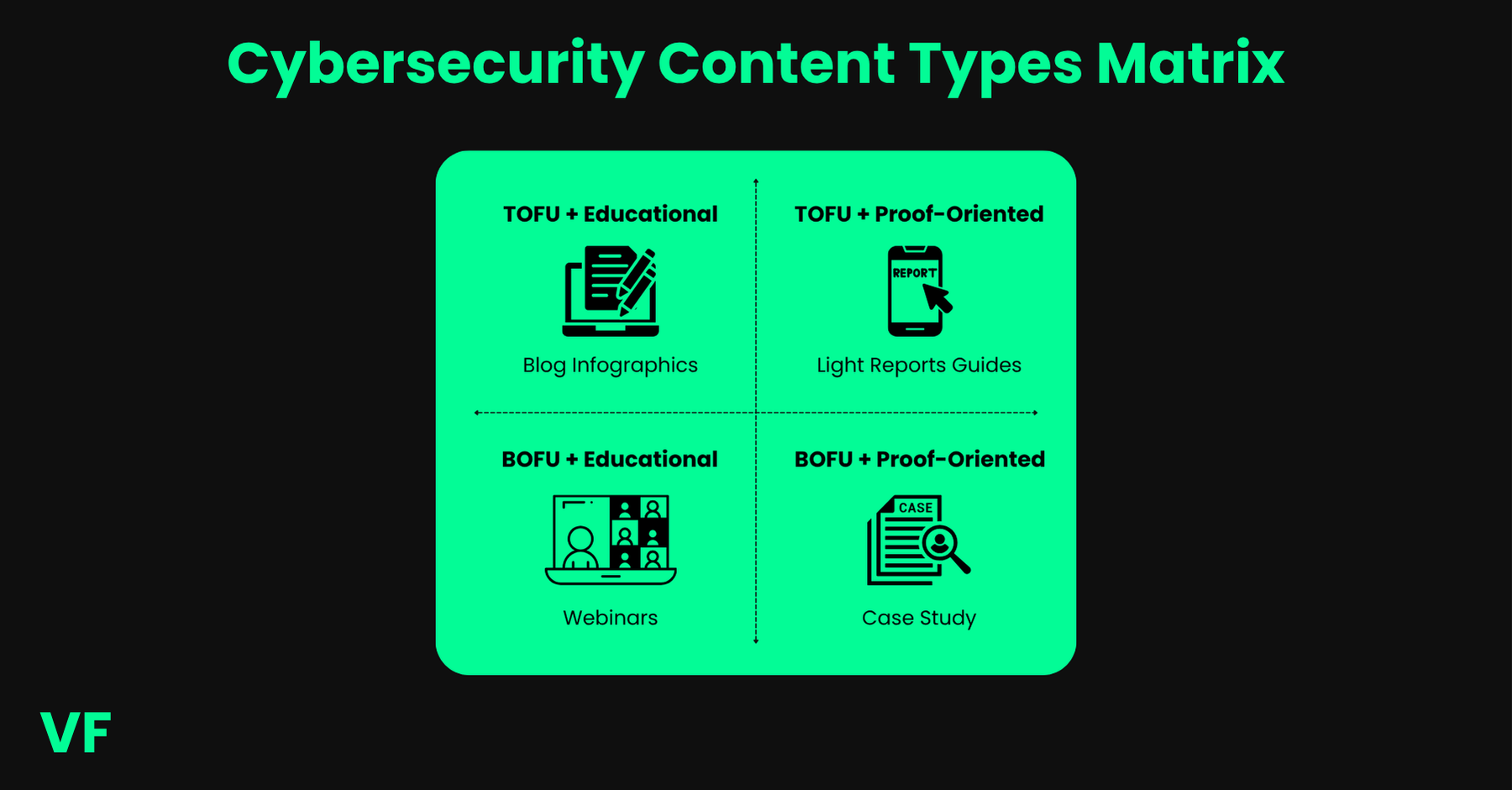
Educational & Trust-Building Content
Begin with content that helps your audience grasp cybersecurity concepts without feeling overwhelmed. Create white papers that unpack industry trends, explainer blogs that break down specific threats, and expert Q&As that address real security concerns.
Keep the tone informative and practical — show what’s changing in the cybersecurity industry and how your cybersecurity company is helping others stay ahead. Educational content like this not only builds trust but also strengthens your visibility through search engine optimization and social media sharing.
Proof & Validation Assets
Once your audience understands the problem, they want proof that your cybersecurity solutions actually deliver. Publish case studies showing measurable results, share compliance mappings like SOC 2 or ISO certifications, and promote analyst reports that validate your product’s performance.
These assets help decision makers justify investment and reduce uncertainty. Ensure your cybersecurity content features real metrics, customer quotes, and data that demonstrate how your cybersecurity company delivers reliable outcomes.
Experience-Driven Formats
Bring your cybersecurity solutions to life with interactive and engaging formats. Demo videos, product tours, and podcasts are excellent for showing how your technology works in real scenarios.
Security scenario simulations are especially powerful for technical buyers who want to see your platform in action. Keep these assets short, visually clear, and focused on solving practical problems. The goal is to make it easy for potential customers to picture themselves using your product confidently — not just reading about it.
Distribution Channels That Work for Cybersecurity
Owned Channels for Authority
Start with platforms you fully control — your website, blog hub, gated resource center, and newsletters. These owned channels let your cybersecurity company build consistent messaging, showcase expertise, and capture leads directly.
Use your blog for educational cybersecurity content, your resource center for white papers and case studies, and your newsletter to share ongoing cybersecurity trends or success stories. A strong owned content strategy keeps your audience engaged while strengthening search engine optimization and long-term brand authority.
Earned Channels for Credibility
Visibility on trusted third-party platforms reinforces credibility. Contribute thought leadership articles to respected cybersecurity publications, pitch expert commentary for PR placements, and share analyst mentions that highlight your product performance.
These earned channels signal validation from the broader cybersecurity industry. They also help you reach audiences who may not be familiar with your brand but are actively researching cybersecurity solutions through online forums or industry media.
Paid Channels for Scale
Paid campaigns help expand your reach quickly and target the right buyer personas with precision. LinkedIn ABM campaigns are effective for connecting with CISOs, IT managers, and technical buyers.
Meanwhile, retargeting ads keep your cybersecurity content visible to people already engaging with your website. Sponsored placements in reputable cybersecurity newsletters can also drive high-quality traffic. When aligned with your broader content marketing strategy, paid distribution turns great content into consistent pipeline growth.
Measuring Cybersecurity Content Marketing Success
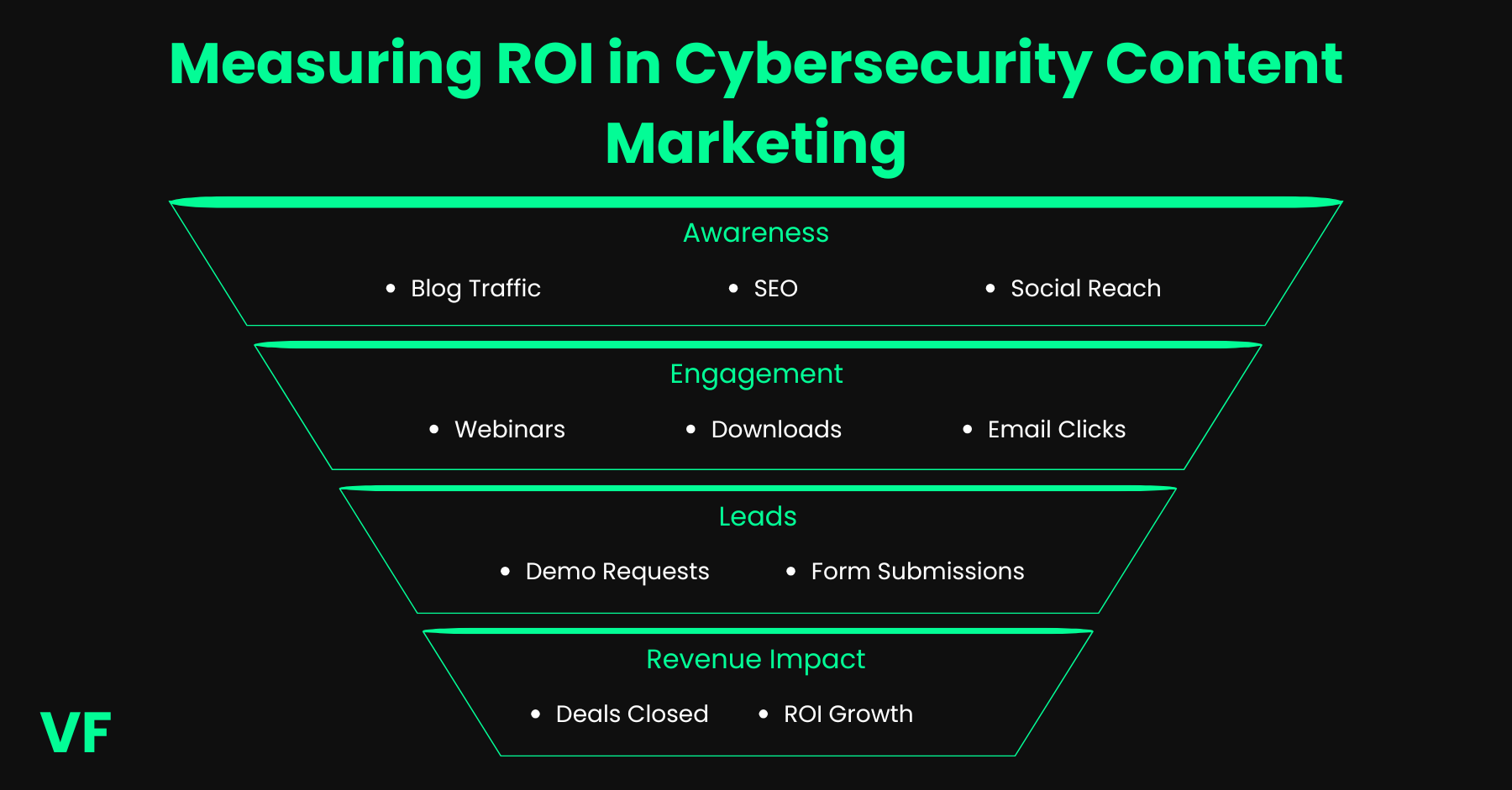
Engagement Metrics That Actually Matter
Go beyond vanity metrics like impressions and focus on engagement that reflects genuine interest. Track time on page, return visits, scroll depth, and resource downloads to understand how well your cybersecurity content connects with readers. These signals show whether people are finding value in your content marketing efforts. For gated content, such as white papers or webinars, monitor completion rates and follow-up actions. The goal is to assess how your cybersecurity content engages potential customers and guides them naturally toward the next step in their journey.
Pipeline and Revenue Impact
Strong cybersecurity content marketing ties directly to revenue, not just lead volume. Track how specific assets influence opportunity creation and deal velocity — for example, which case studies or comparison guides get cited in sales conversations or downloaded before meetings. Connect your content marketing strategy with CRM data to see where each asset contributes in the pipeline. When sales and marketing teams share this insight, it becomes clear which types of cybersecurity content actually help close deals and which need refining.
Trust and Brand Authority Signals
Authority takes time, but it’s measurable. Watch for signals like speaking invitations at security conferences, analyst citations in reports, and backlink growth from credible cybersecurity industry sites. These are signs that your cybersecurity company is recognized as a thought leader others turn to for insight. Keep track of organic mentions on social media and inclusion in industry roundups too. When people quote, share, and link to your content, it demonstrates that your brand’s credibility is growing — a strong validation of long-term cybersecurity content marketing success.
Should You Hire a Cybersecurity Content Marketing Agency?
If your team lacks cybersecurity expertise or struggles to produce consistent, effective content, hiring a cybersecurity content marketing agency can save time and boost results. Agencies bring technical accuracy, SEO expertise, and the bandwidth to scale campaigns that educate, nurture, and convert. They’re especially useful for complex products, global programs, or when you need full-funnel content that aligns with sales.
What to Look for in a Partner
Choose an agency or consultant with real cybersecurity experience not general B2B marketers. Ask for examples of technical content, proof of results, and familiarity with your target audience, from CISOs to IT managers. The best partners combine technical depth, strong SEO skills, and a clear process for aligning with your sales and demand gen teams. They should make your life easier, not add more work.
Agency vs. Freelancer vs. In-House
Agencies bring resources, but you’re often one of many clients — which can mean slower responses and cookie-cutter strategies. In-house teams offer control but take months to build and can be costly to maintain. A freelance cybersecurity marketing consultant gives you the best of both: deep, specialized expertise, direct collaboration, and faster execution without the overhead. You work with someone who understands your product, market, and goals — and adapts quickly as things evolve. Want to see how that could work for your company? Book a quick strategy call and let’s identify where your content can perform better.
